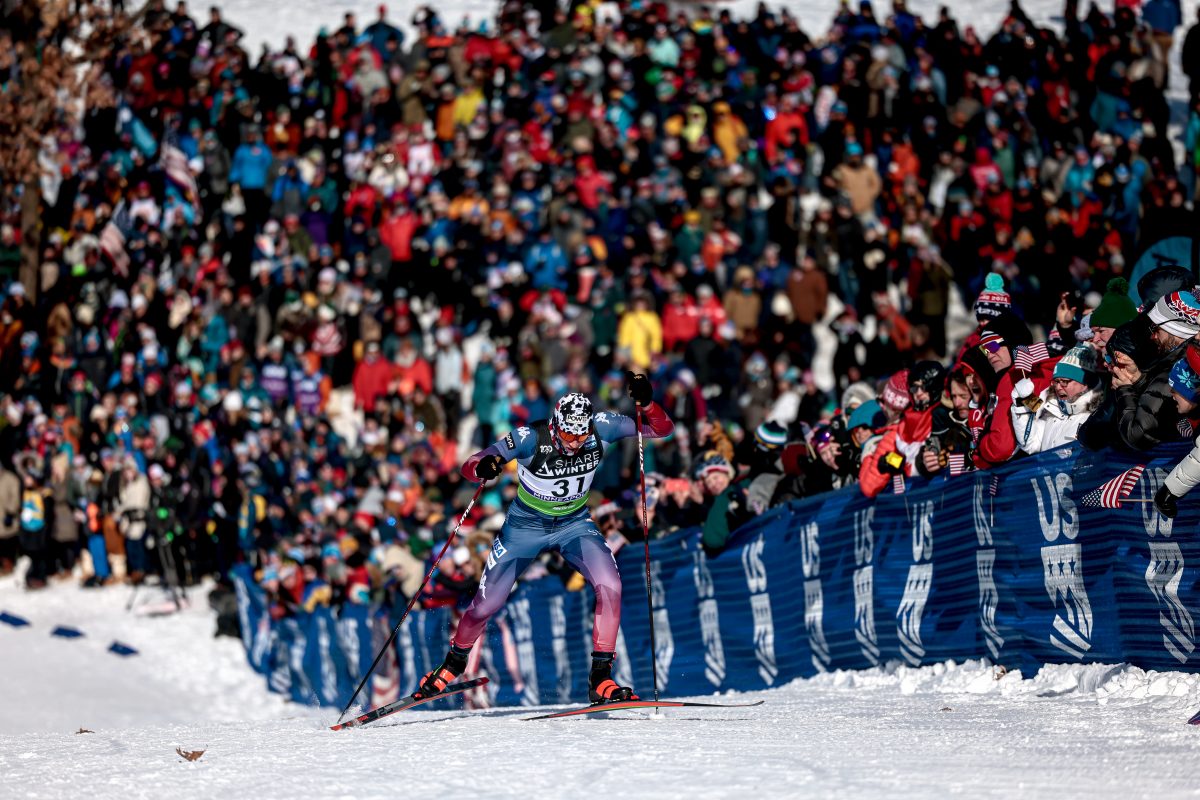CALGARY — Five of Canada’s top female biathletes shed their lycra race suits to officially launch a nude calendar on Wednesday which they created to celebrate healthy, active women’s bodies, and also to generate money to fuel their quest for the international podium.
Zina Kocher, of Red Deer, Alta.; Sandra Keith, of Calgary; Rosanna Crawford, of Canmore, Alta.; Megan Imrie, of Falcon Lake, Man.; and Megan Tandy, of Prince, George, B.C., developed the plan to pose nude together in Bold Beautiful Biathlon, which is on sale now for $25 at www.boldbeautifulbiathlon.com on the Internet.
With a goal of targeting financial support from corporate Canada for their Olympic journey, the five Canadian women turned up the heat on a frigid Calgary morning when they roller skied through the downtown core during noon hour with nothing more than shorts, race bibs for tops, and their traditional biathlon rifles locked on their backs.
“We are extremely appreciative of the generous financial support given to our program by Sport Canada, and by Own the Podium to the athletes on our team that are projected to achieve excellence,†said Zina Kocher, a targeted athlete herself and the leader of the Canadian Biathlon Team, who in 2006 became the first Canadian to win a World Cup medal since Myriam Bedard did more than a decade ago. “But our sport remains significantly under-funded compared to our competitors, and one of the few winter sports in this country without a title sponsor or personal sponsors.â€
Funding for an athlete’s annual budget comes from a variety of avenues. Personal sponsorships are a core component to covering the many annual expenses high-performance athletes face for both training and competition. Despite being one of the lone fully-funded athletes in the national biathlon program, Kocher and long-time World Cup and Olympic teammate Sandra Keith, took the lead in rallying their World Cup comrades to aggressively seek additional funding opportunities.
“We believe there is a tremendous opportunity for someone in corporate Canada to not only invest in this team and our drive to the Olympic podium, but also to invest in building a new image for young Canadian girls to look up to,†said Keith, who enjoyed a breakthrough season on the World Cup last year which included a career-best 11th-place result. “Contrary to a lot of images young girls are seeing on television and in magazines about the ideal woman’s body, it is a healthy athletic body that we should all be looking to maintain. You don’t need to be a high-performance athlete to be fit, and we are encouraging all women to be proud of their bodies.â€
The photos of Keith, Kocher and their teammates were taken by Rachel Boekel and Adrian Marcoux in Canmore, Alta. Each athlete will be featured on two pages of the calendar, along with four group photos.
Nude calendars have become more common as fund-raising tools. Around the same time as the the “Nordic Nudes” calendar of 2001, the Australian Women's Soccer team released a calendar of artistic photos featuring full-frontal nudity. High-jumper Amy Acuff organized Omni-Lite Millennium Calendar of Champions featuring Acuff and 11 other female track and field athletes in black-and-white photographs, mostly nude. Currently, a calendar titled “Women of Curling” is on sale, featuring nude curling athletes from around the world. The list goes on – golfers, rugby teams, and many more have created nude calendars to support their sport or cause.
At the time of the “Nordic Nudes” calendar, the practice was far from accepted, and both the Canadian women's cross-country effort and the Australian women's issue generated significant controversy, often from activists who claimed that the calendars were demeaning to women, both as people and as athletes. Critics pointed out that one rarely, if ever, saw male athletes producing nude calendars. But the calendars sell well, inspiring others to follow suit, and it appears that the practice has become generally accepted.
The Canadian biathletes were inspired to take on the project when thinking back to the success two of their Olympic heroes in cross-country skiing, Sara Renner and Beckie Scott, had in raising funds after producing a similar calendar in 2001. Renner and Scott, along with three other teammates, tastefully took their clothes off to also raise the profile of their sport while showing the world cross-country skiers were fit and healthy people.
“An athlete’s livelihood depends on their bodies and I believe athletes should be proud of their bodies. This calendar
Sales of the calendar took off for Canada’s cross-country ski women, which helped finance their preparations for the 2002 Olympic Winter Games in Salt Lake City where Beckie Scott became the first North American woman to win an Olympic medal when she won gold in the pursuit race. Scott and Renner later joined forces to win a silver medal in the team relay at the 2006 Olympics.
“A healthy, female body is a beautiful thing and if these girls choose to celebrate it with a calendar, then all the power to them,†said Scott, who also became a mother after retiring in 2006 with 17 World Cup and two Olympic medals. “The unique thing was we created this calendar right on the cusp of our team making huge strides in the sport internationally, and I hope this marks the same trend for the biathlon women. I wish them the very best and give them my full support.â€
Nude calendars have become more common as fund-raising tools. Around the same time as the the “Nordic Nudes” calendar of 2001, the Australian Women's Soccer team released a calendar of artistic photos featuring full-frontal nudity. High-jumper Amy Acuff organized Omni-Lite Millennium Calendar of Champions featuring Acuff and 11 other female track and field athletes in black-and-white photographs, mostly nude. Currently, a calendar titled “Women of Curling” is on sale, featuring nude curling athletes from around the world. The list goes on – golfers, rugby teams, and many more have created nude calendars to support their sport or cause.
At the time of the “Nordic Nudes” calendar, the practice was far from accepted, and both the Canadian women's cross-country effort and the Australian women's issue generated significant controversy, often from activists who claimed that the calendars were demeaning to women, both as people and as athletes. Critics pointed out that one rarely, if ever, saw male athletes producing nude calendars. But the calendars sell well and bring mainstream attention to fringe sports, inspiring others to follow suit, and it appears that the practice has become generally accepted.
Canada’s biathletes will be hoping history repeats itself as well — both with sales of the calendar and on the biathlon course. The calendar will begin selling across the country immediately, while the team will hit the start line for their first World cup race of the season one month later in Sweden.
Images of the release event from CTV.ca can be found here.
To purchase a Bold Beautiful Biathlon calendar, or for more information on the project, please visit www.boldbeautifulbiathlon.com on the Internet.
Editor's Note: The bulk of this article was drawn from a press release announcing the event. The section on the recent history of nude athletic calendars was contributed by FasterSkier staff.




